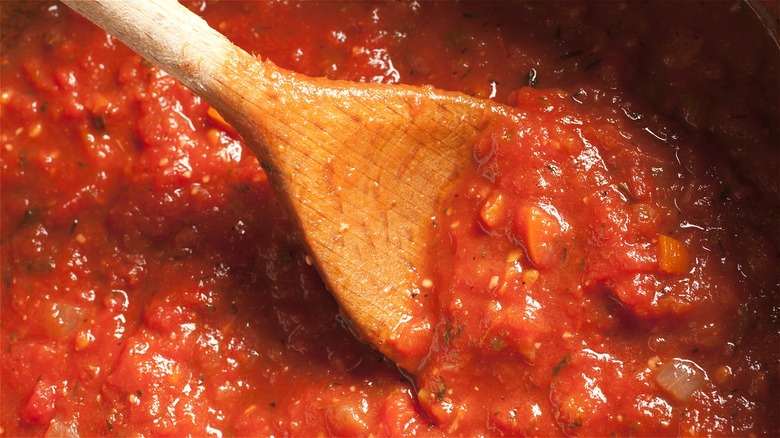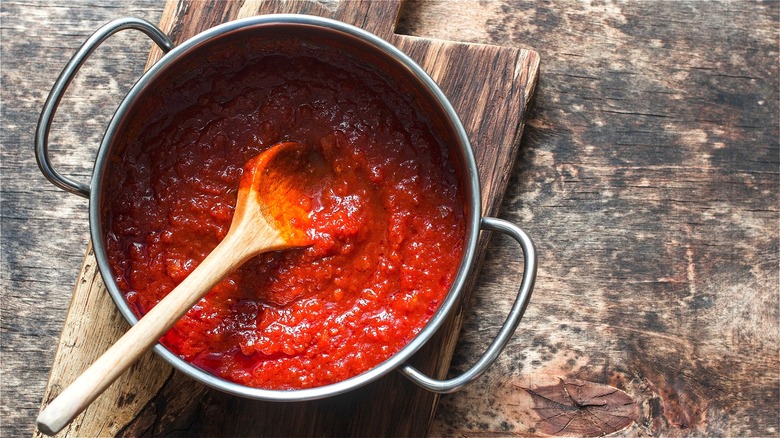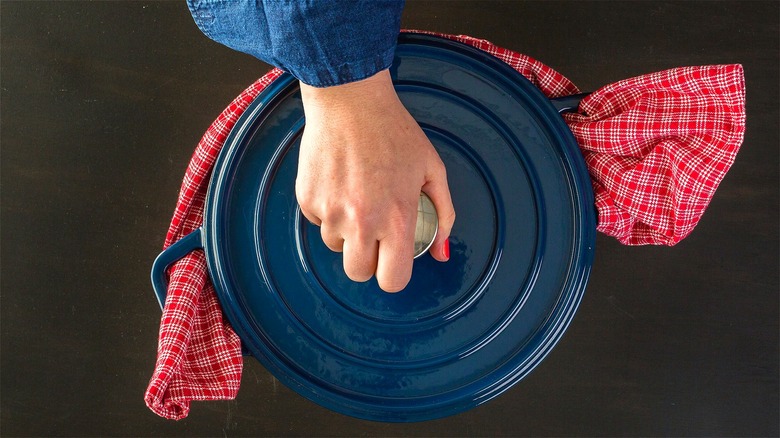The Science Behind Why Tomato Sauce Splatters All Over Your Kitchen
When homemade spaghetti and meatballs are on your dinner menu, you might already be stressing about the potential mess this thick and hearty dinner is sure to leave on your stove. (And likely your apron.) If you're left wondering why tomato sauce always seems to splatter everywhere amidst the simmering process, you're not alone.
Tomato sauce includes ingredients that produce a rich and compelling flavor and texture. Tomatoes contain acid and sugar but also pectin, which thickens with heat. Since this complex sauce isn't fluid like water, gas bubbles have difficulty escaping. The pressure from evaporated water eventually builds up to the point of release, but first, these determined gas bubbles need to work their way to the surface.
Your sauce tends to fly everywhere because trudging through a thick semi-solid mixture takes a lot of work. Since this acidic food is made from a combination of liquids and solids, once gas bubbles reach the topmost surface, they break through with a vengeance, creating quite a mess. Luckily, there are a few simple ways to prevent this family favorite meal from leaving your kitchen looking like a disaster.
How to prevent tomato sauce from splattering
Whether you're making pasta with bolognese sauce or traditional red sauce, there are a few easy ways to contain out-of-control splattering. For starters, make sure to use a large pot. A pot with higher walls prevents sauce bubbles from making it over the edge. Make sure to keep the temperature of your sauce medium to low and stir frequently. Stirring helps your tomato-based mixture remain evenly tempered and prevents hot spots. Intermittent stirring also proactively helps move evaporated water to the surface, releasing gas bubbles faster and more frequently. Tomato sauce on high heat may lead to excessive pressure, causing large sauce bubbles to explode with little notice. Aim to keep your sauce at a delicate simmer instead of a boil.
If you want a guaranteed product that works to contain tomato splatter and other bubbling soups and sauces, consider purchasing a splatter shield. Most stainless steel splatter shields cost under $20 and come in various sizes. If you don't want to spend money, you can also try using the lid of your designated cooking pot. However, there is more than one reason to avoid completely covering your simmering tomato sauce while cooking.
The right way to cover simmering tomato sauce
Covering the pot may seem like the easiest solution to prevent the sauce from splattering all over your stove, but tomato sauce can't be reduced properly when completely covered. The low and slow concentration of strained tomatoes, various aromatics, and olive oil make Italian tomato sauce rich and flavorful. Moisture can't properly evaporate and be released from a sealed pot. This leads to a tomato sauce with less pronounced flavor and thinner consistency.
To make the lid work to your advantage, place it carefully so a bit of room is left for steam to escape. The lid acts as a splatter screen alternative, catching any explosive sauce bubbles. For more preventative mess-free simmering, every time you remove your lid to stir the contents, first move your pot off the heat to an unused burner to slow gas bubbles from breaking through the surface.
Even though a partially covered pot is a somewhat viable solution, there are many mindful ways to prevent tomato sauce from wreaking havoc on your stovetop and kitchen counters. Now that you have a better understanding of why tomato sauce has the potential to explode, next time, try varied solutions to contain the mess.


